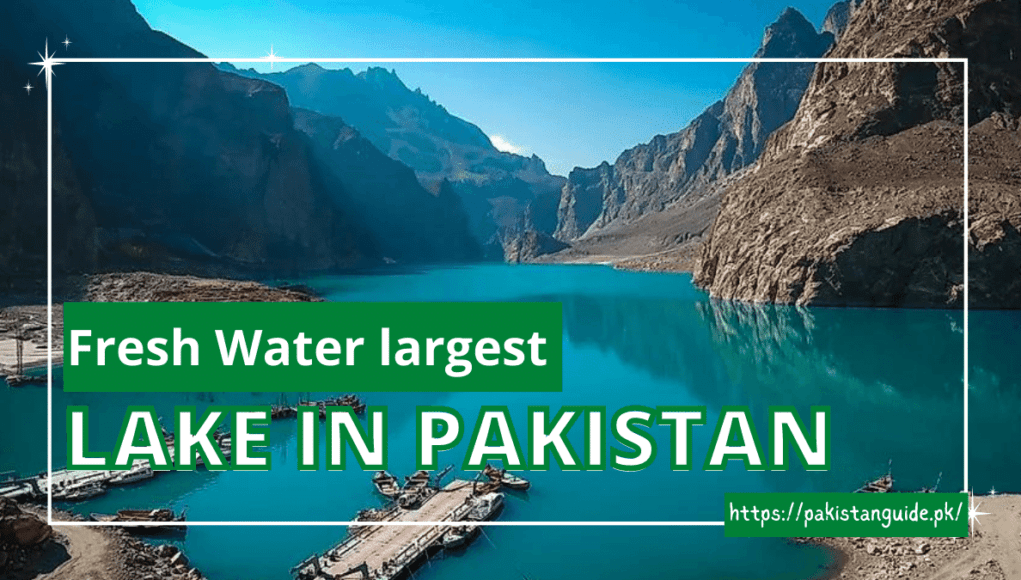The largest natural fresh Lake in Pakistanis Lake Manchar. This is often placed west of the Indus in Jamshoro and Daddu District Sindh. Numerous tiny streams within the Kirthar Mountains feed the Manchar Lake. This Lake then empties into the Indus. The monsoon season fluctuates within the space of the Lake. Manchar Lake’s space ranges from 36 sq. kilometers to five hundred sq. kilometers relying upon the annual rain within the region. If you want to know which is the largest Lake in Pakistan?

Manchar is the most significant shallow water Lake and the largest freshwater lake in Pakistan. It’s settled at 18 km from Sehwan Sharif on the side of the watercourse Indus, in district Jamshoro. The world of the lake rises and falls with the modification of seasons from very little as 350 kilometers to the maximum amount of 520 kilometers.
The Lake accumulates water from varied brooks within the Kirthar Mountains and empties them into the Indus. Manchar is an artificial Lake created in 1930, once the Sukkur barrage was made on the watercourse Indus. The Lake is sustained by two canals, the Aral and the Danister, from the Indus waterway.
Table of Contents
History of Manchar Lake
The bank of the Lake is home to some superb archeologic sites together with Ghazi crowned head and Wahi Pandhi Al Murad Mound. On the sting of the side are the notable areas of Lal Chatto, Lakhiyo, and Mashak Lohri. These sites are the major ancient sites around the Lake and date back to the Harappan culture. This Lake originated once a branch from the Indus started flowing through Kashmore. It developed by change of integrity Hamal Lake through Main NARA valley.
Additionally, in 2010, this Lake overflowed. This Lake has an additionally visaged abundant crisis. For example, in 1958, this Lake entirely evaporated due to drought.
Importance of Manchar Lake
Manchar Lake is the largest Lake in Pakistan with shallow freshwater. It plays a vital role as a natural environment. So, it’s environmentally essential. The Lake supports varied fisherfolk who rely upon the fishes within the Lake. The water of the Lake is accustomed to being evident; however, environmental degradation has born the standard of the Lake. The NARA valley has to lead the Lake to deliver ecological degradation.
The decline of the fishery
Lake Manchar- the largest natural Lake in Pakistan is genuinely an artificial lake created in 1932 by building two channels derived from the watercourse and the Surruk dam. Its purpose was to manage the floods and permit the growth of agricultural land through irrigation, and for nearly a century, this goal was achieved.
Problems started in 1982, once the govt. Determined to create a network of channels and drains on the right bank of the Indus. Called RBOD (Right Bank outlet Drain), the infrastructure aimed to forestall water work and salinity that destroyed giant tracts of cultivatable land around the cities of Dadu and Larkana, upstream of Lake Manchar.
But the result wasn’t the required one; salinity was exaggerated, and also, the water began to be impure by industrial discharges. Aquatic life deteriorated, and fishing declined drastically. In keeping with the PFF, while 2,300 metric tons were caught in 1944, 700 were reached by the tip of the 1980s. From 1992 forwards, discharges exaggerated so did salinity. Today, the waters of Lake Manchar don’t manufacture over seventy-five metric a lot of fish.
The fate of Lake
The RBOD is fed by tiny emptying channels that transport agricultural runoff from the world placed on the right bank of the Indus. Woefully, in 2004, thirty people died from drinking contaminated water. This occurred as a result of once the water level falls within the Indus, the concentration of toxics within the Lake will increase, and diarrhea, inflammatory disease, typhoid fever, hepatitis, as well as waterborne diseases. As life within the Lake was destroyed, the support of the communities was affected.
The fishers lost them suggests that of survival, farmers were unable to use the land to grow crops, and also the girls of Manchar suffered the forcefulness of those changes. Because of the successfulness of the community modified, women’s health deteriorated, infant deathrate exaggerated, youngsters suffered from numerous waterborne unhealthiness, and a prosperous community step by step slipped into poorness.
Lake Manchar- Pakistan’s floating village
Manchar Lake, the floating village, lies eighteen km west of Sehwan Sharif on the Indus main road. It’s claimed to be one of the largest fresh lakes in Pakistan and the solely Lake home to fishers living on wood boathouses for many years.
The largest freshwater lake of Pakistan spreads over a neighborhood of 233 sq. km and gets its water from the Kirthar hill torrents and watercourse Indus. The fisher people, called Mirbahar or Mohannas, are living here for hundreds of years and survive on the accessible fish stock within the Lake.
A carpeted road towards the west on the main Indus main road ends in Manchar Village. The village is small, primarily the primary market thronged with fishers in teams, sipping chai, looking at TV, and discussing native politics.
The market has a mosque, a hotel, a grocery store, and a vegetable shop. The house is solely a wood boat with a compartment within the middle that acts as a front room, with a compartment for storage and sleeping on one facet. One boat permits eight to ten folks to sleep on. Each fishermen’s family owns a house and a smaller boat to commute.
The fishers live away from what others think about the essential wants of life, like electricity. They board complete harmony with nature. Each day with the sunrise, their day begins, and with the sun, it sets too. They follow the lunar calendar. The fishers living on the largest Lake in Pakistan are poor and provide all the fish they catch to the contractor who hires them for at least a daily wage. The Lake is currently heavily impure and receives less fresh and virulent water-primarily drain water from Main NARA valley.
Drain water containing industrial and agricultural waste is the main reason for contamination within the Lake. The govt. has planned to divert the drain to the Arabian Sea via RBOD. However, progress on this front has been plodding. The area was a severe massive stopover for migratory birds from Punjab and once provided support to 10,000 fishers living on 2000 boats. Now, it’s simply a vulnerable land.











